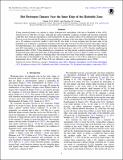Hot Hydrogen Climates Near the Inner Edge of the Habitable Zone
Author(s)
Koll, Daniel; Cronin, Timothy Wallace
DownloadPublished version (824.6Kb)
Publisher Policy
Publisher Policy
Article is made available in accordance with the publisher's policy and may be subject to US copyright law. Please refer to the publisher's site for terms of use.
Terms of use
Metadata
Show full item recordAbstract
Young terrestrial planets can capture or outgas hydrogen-rich atmospheres with tens to hundreds of bars of H[subscript 2], which persist for 100 Myr or longer. Although the earliest habitable conditions on Earth and terrestrial exoplanets could thus arise while the atmosphere is still dominated by H[subscript 2], the climatic effects of H[subscript 2] remain poorly understood. Previous work showed that H[subscript 2] induces strong greenhouse warming at the outer edge of the habitable zone. Here we use a 1D radiative-convective model to show that H[subscript 2] also leads to strong warming near the inner edge of the habitable zone. Unlike H[subscript 2]'s greenhouse warming at the outer edge, however, its effect near the inner edge is driven by thermodynamics: H[subscript 2]'s large thermal scale height allows the atmosphere to store more water vapor than either a pure H[subscript 2]O atmosphere or an atmosphere with a heavy background gas, such as N[subscript 2] or CO[subscript 2], thereby amplifying the greenhouse effect of H[subscript 2]O. Using idealized gray calculations, we then present a general argument for how different background gases affect the inner edge of the habitable zone. H[subscript 2] stands out for its ability to induce novel "soufflé" climates, which further support its warming effect. Our results show that if the earliest conditions on a planet near the inner edge of the habitable zone were H[subscript 2]-rich, they were likely also hot: 1 bar of H[subscript 2] is sufficient to raise surface temperatures above 340 K, and 50 bar of H[subscript 2] are sufficient to raise surface temperatures above 450 K.
Date issued
2019-08Department
Massachusetts Institute of Technology. Department of Earth, Atmospheric, and Planetary SciencesJournal
Astrophysical Journal
Publisher
American Astronomical Society
Citation
Koll, Daniel D. B., and Timothy W. Cronin. “Hot Hydrogen Climates Near the Inner Edge of the Habitable Zone.” The Astrophysical Journal 881, 2 (August 2019): 120. © 2019 The American Astronomical Society.
Version: Final published version
ISSN
1538-4357
0004-637X